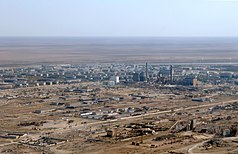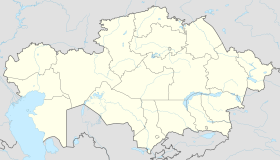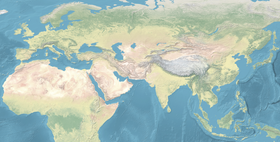|
Baikonur
Baikonur (Russian: Байконур [bəjkɐˈnur]; Kazakh: Байқоңыр, romanized: Baiqoñyr [bɑjqoˈŋɤr]) is a city in Kazakhstan on the northern bank of the Syr Darya river. It is currently leased and administered by the Russian Federation as an enclave until 2050.[3] It was constructed to serve the Baikonur Cosmodrome with administrative offices and employee housing. During the Soviet period, the town was known as Leninsk, and was sometimes referred to as Zvezdograd (Russian: Звездоград, lit. 'Star City').[4] It was officially renamed Baikonur by Russian president Boris Yeltsin on December 20, 1995. The Russian controlled area is an ellipse measuring 90 kilometres (56 mi) east to west by 85 km (53 mi) north to south, with the cosmodrome situated at the area's centre. Foreign visitors and tourists can visit the cosmodrome and city but need to obtain a specific permit from Roscosmos.[5] HistoryHistorical affiliations
The original Baikonur (Kazakh for "wealthy brown", i.e. "fertile land with many herbs") is a mining town 320 kilometres northeast of the present location, near Dzhezkazgan in Kazakhstan's Karagandy Region. Starting with Vostok 1 in April 1961, the launch site was given this name to cause confusion and keep the location secret. (The original Baikonur's residents took advantage of the confusion by ordering and receiving many scarce materials before government officials discovered the deception.)[6] Baikonur's railway station predates the base and retains the old name of Tyuratam. This was the original Soviet railway station (railhead) on the Moscow to Tashkent Railway that the Cosmodrome was initially named after. The fortunes of the city have varied according to those of the Soviet or Russian space program and its Baikonur Cosmodrome. Due to the city's military and scientific significance, it was closed off by Soviet authorities. It did not appear on maps available to the general public during the Soviet period prior to perestroika. The Soviet government established the Nauchno-Issledovatel'skii Ispytatel'nyi Poligon N.5 (NIIIP-5), or Scientific-Research Test Range N.5 by its decree of 12 February 1955. The U-2 high-altitude reconnaissance plane found and photographed the Tyuratam missile test range (cosmodrome Baikonur) for the first time on 5 August 1957.[7][8] The town has unique ties with space, and hence the history of the rocket building and space binds all the sights in the area and the cosmodrome. However, there are only a few exceptions: old locomotive, an Orthodox Church and a new mosque.[9] The city administratively belongs to the Odintsovsky District of Moscow Oblast.[10][11] ClimateBaikonur features a cold desert climate (BWk). Summers are hot with July highs averaging slightly over 34 °C (93 °F), while winters are cold, with longer periods of sustained below-freezing temperatures.[12]
Places of interestSouth of city center, near the Syr Darya River there is a large park with several sports and amusement facilities. Among these is a ferris wheel, which is no longer in use. The park is located at coordinates 45°36′42″N 63°19′06″E / 45.61167°N 63.31833°E. Gallery
See alsoReferences
Further reading
External linksWikimedia Commons has media related to Baikonur.
|
||||||||||||||||||||||||||||||||||||||||||||||||||||||||||||||||||||||||||||||||||||||||||||||||||||||||||||||||||||||||||||||||||||||||||||||||
Portal di Ensiklopedia Dunia













